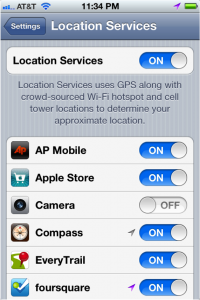Developing cell phone rules:
 1. When and where you can use your phones.
1. When and where you can use your phones.
Set an example by what you do. How many times do you see parents in public using their phones for emailing, calling, texting, browsing or whatever when they’re with their kids. I know that sometimes you have to know certain things (I know I do), but most of the time, I would expect that what you’re looking at can wait. Tonight I had an opportunity to spend the afternoon with one of my kids and the temptation is really strong to check my phone for messages or the weather or pretty much anything. But, I had to force myself to STOP and keep my phone put away so I could concentrate on the special time with my child. There’s almost nothing that can’t wait while you’re at the playground. Kids see this and think it’s ok to be on your phone all the time when it’s really not all that healthy. More time on the gadget is more potential for abuse also.
Also, find out the cell phone rules for places where your kids visit. What are the rules at school, summer camp, other activities, friends houses, etc. Find out these rules and make sure your kids know that you support these rules and that they need to follow them. This helps keep them safer and will make it much easier for them, you and the people who are setting the rules.
2. Use their manners on cell phones, too.
Treat people the way they’d like to be treated. Just because you’re not face to face with someone doesn’t mean you can throw manners out the window. In fact, because you’re not face to face is more reason to be more polite. Without the audio or visual clues that promote good communication and feedback, it’s very easy to miscommunicate and offend or hurt someone.
3. Think about privacy and safety.
Photo- and video-sharing on the go. With the incredibly easy ways to share content these days, it’s important to make sure that any photos or videos your kids take are appropriate for posting. Obviously making sure the content is rated “G” and age appropriate is the first thing to watch out for and then to see where they’re posting this information. (See this post for more information on how to rate apps and see what NOT to use, and this post for Facebook privacy.)
4. Filters on home computers don’t apply on phones.
Internet filters are a great idea. But, they don’t work on cellphones. While you can subscribe to services that will allow you access to all data on your child’s phone, they aren’t fool-proof, and you can’t be with your kids all the time. For instance, kids can easily just use a friend’s phone.
Because there’s always a way for kids to get around a filter or other block to the internet, the best way to keep your kids safe is to make sure your kids know the rules, what to watch out for and how to behave appropriately.
 5. Choose the right options and features for ALL phones.
5. Choose the right options and features for ALL phones.
Location Services are big, and your phone probably came with them turned on. Be aware of Social Mapping and how the GPS in your phone can track you and tell others where you are. Visit the settings in your phone today to learn more about this. The iPhone has good controls over this and you can turn it on or off for the entire phone or for specific apps.
Remember, your smart phone is an amazing tool. It’s so good that it can also get you into trouble if you aren’t careful. Following a few simple guidelines is easy to do, but nothing, I repeat nothing will be better than a conversation with your kids about this. And preferably, you’ll have several more conversations as they get older and more capable with more and more freedoms. Please keep in mind these cell phone safety tips for your kids.
Internet safety is more about your relationship with your kids than about technology!


